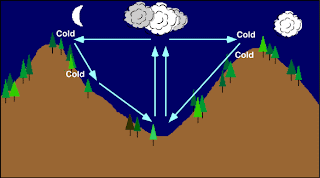 |
| a monsoon view in India |
The major controlling factor over a tropical monsoon climate is its relationship to the monsoon
circulation. The monsoon is a seasonal change in wind direction. In
Asia, during the summer (or high-sun season) there is an onshore flow of
air (air moving from ocean towards land). In the “winter” (or low-sun
season) an offshore air flow (air moving from land toward water) is
prevalent. The change in direction is due to the difference in the way
water and land heat.
Changing pressure patterns that affect the seasonality of
precipitation also occur in Africa though it generally differs from the
way it operates in Asia. During the high-sun season, the Intertropical convergence zone (ITCZ) induces rain. During the low-sun season, the subtropical high creates dry conditions.[2] The monsoon climates of Africa, and the Americas for that matter, are typically located along tradewind coasts.















